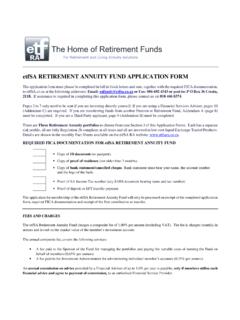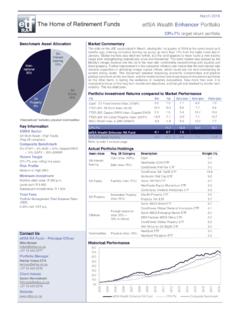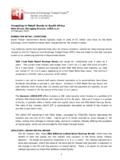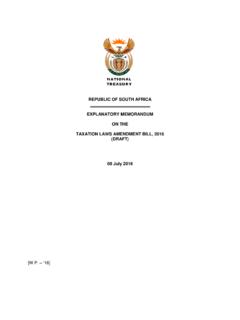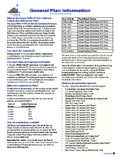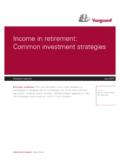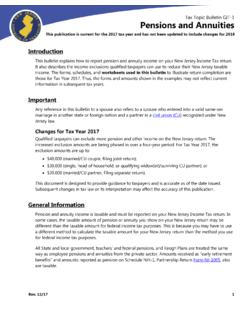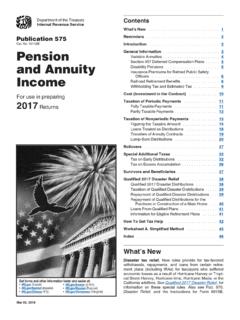Transcription of Taxation and Retirement Annuity Funds - etfSA
1 Board of Trustees: J Moses (Chairman) (Ind); D Clifford (Ind); N G Gwatidzo (Ind); C du Toit (Ind); N Visser; M F Brown (Principal Officer) Taxation and Retirement Annuity Funds Mike Brown, Principal Officer, etfSA RA fund March 2016 The latest changes to the Taxation benefits attached to Retirement Funds , arising from the 23rd February 2016 Budget Speech and from the Taxation Laws Amendment Act, which came into effect on 8th January 2016, are discussed in this paper. The Revenue Laws Amendment Bill, issued in February 2016, which postponed some of the provisions relating to the Taxation and annuitisation of provident Funds , has also been taken into account. The following conditions and Taxation benefits will apply to Retirement Funds for the 2016/2017 tax year. 1. CONTRIBUTIONS TO A Retirement fund (includes Retirement Annuity Funds , Pension Funds and Provident Funds ) The deductions from tax for contributions to such Retirement Funds by an individual taxpayer is limited to 27,5% of the greater of remuneration (for PAYE purposes) or taxable income.
2 For the first time, contributions to provident Funds , by both employers and employees, can be included in the 27,5% contribution levels. Any Funds received from a lump sum withdrawal from a Retirement fund , or severance benefits cannot be included in the calculation of taxable income. Any contribution made by an employer to a Retirement fund on behalf of its employees, is now classified as a fringe benefit, and such contributions are now treated as a contribution by the individual employee. The individual can now aggregate both the contributions of the employer and themselves and can deduct such contributions from their income for tax purposes, up to 27,5% of their taxable or remuneration income. The deduction by an individual to a Retirement fund is subject to a maximum of R350 000 per tax year. This includes both member and employer contributions. In practice, if a members remuneration or taxable income is R1 272 727, and the contributions are 27,5% of such income, the maximum deduction of R350 000 will be realized in the tax year.
3 2 Any contributions above 27,5% of income, or R350 000, will not be allowed in the tax year of assessment, but can be carried forward for deduction in the next tax year. If the member is not able to claim such excess contributions as a tax deduction, before retiring from the fund , the member can then, under the Second Schedule to the Income Tax Act, claim deductions from lump sums withdrawals from the Retirement fund , or alternatively, as a reduction in any taxable income, drawn from an Annuity policy. 2. WITHDRAWALS FROM A Retirement fund BEFORE Retirement Consists of lump sums withdrawn from a pension fund , preservation fund , or provident fund , on leaving your employment. Although you can only withdraw from a Retirement Annuity fund on reaching Retirement (at age 55 or older), under certain conditions, (assignment in terms of a divorce order for instance), withdrawals can be made from a RA fund , prior to Retirement . The following tax rates apply to all pre- Retirement withdrawals from Retirement Funds .
4 Retirement fund LUMP SUM WITHDRAWAL BENEFITS Taxable Income (R) Rate of Tax (R) 0 25 000 0% of taxable income. 25 001 660 000 18% of taxable income above 25 000. 660 001 990 000 114 300 + 27% of taxable income above 660 000. 990 001 and above 203 400 + 36% of taxable income above 990 000. Source: SARS. 3. WITHDRAWALS FROM A Retirement fund ON Retirement Lump sums withdrawn from a Retirement fund , including pension Funds , preservation Funds , provident Funds or Retirement Annuity fund on Retirement , are taxed as shown below. These also apply in the case of death, or termination of employment due to sickness, accident, injury or incapacity or on the termination of the employers trade. This includes severance benefits from arrangement with an employer due to relinquishment, termination, loss, repudiation, cancellation or variation of a person s office or employment, retrenchment packages. 3 Retirement fund LUMP SUM BENEFITS OR SEVERANCE BENEFITS Taxable Income (R) Rate of Tax (R) 0 500 000 0% of taxable income.
5 500 001 700 000 18% of taxable income above 500 000. 700 001 1 050 000 36 000 + 27% of taxable income above 700 000. 1 050 000 and above 130 500 + 36% of taxable income above 1 050 000. Source: SARS. The above rates of tax also apply to the annuitisation process, whereby a member can withdraw up to one-third of their capital as a lump sum from a Retirement fund on taking Retirement . The above tax rates apply to the lump sum withdrawals. The balance of two-thirds is used to purchase an Annuity . The tax on lump sum withdrawals is reached by taking into account all lump sum withdrawal benefits accruing from March 2009 and all severance benefits accruing from March 2011. The tax applies to the aggregate of all such lump sum or severance benefits. 4. DE MINIMIS THRESHOLD The minimum threshold that requires the annuitisation of a pension or Retirement Annuity fund has been increased from R75 000 to R247 500. If the total value of the Retirement fund does not exceed the de minimis threshold, then the member can take the full amount as a lump sum payment without being required to enter into an Annuity arrangement.
6 The lump sum withdrawal is taxed according to the table in Section 3 of this document. 5. EXCESS CONTRIBUTIONS The Taxation benefits applicable to RA fund have the benefits of lowering the investors income tax liability. If contributions in excess of the tax deductible limits are made to a RA fund , this unclaimed amount carries forward to subsequent years. If, by Retirement age, the full tax credit has not been fully utilized, then the unused deduction can be used against the lump sum taken on Retirement . If the lump sum is not sufficient to fully utilize the unused tax deduction, then it can be offset against the income received from an Annuity , with effect from March 2014. 4 6. DEATH BENEFITS Any benefits paid on death from both a Retirement Annuity fund and a living Annuity (after Retirement ) are excluded from the member s estate. In terms of Section 37c of the Pensions fund Act, the Trustees of the RA fund , will distribution any death benefits directly to the beneficiaries and/or dependents of the member and these assets to not form part of the Estate, to be distributed by the executor of the Estate.
7 This can lead to significant savings in Estate Duties and in the fees payable to the executors of the Estate. 7. Taxation OF ASSET AND INCOME IN A RA fund No capital gains tax or Taxation on interest or dividends received in the fund is payable. So growth in the RA fund is tax free. ---------------------------------------- ---------------------------------------- ------- For queries about Retirement Funds , the etfSA RA fund , the etfSA Living Annuity fund products and financial advice, please contact Mike Brown on Tel: 011 274 6171 or Email: Kind regards M F BROWN Principal Officer etfSA Retirement Annuity fund Terms and conditions: Redistribution, reproduction, the resale or transmission to any third party of the contents of this article and this website, whether by email, newsletter, internet or website, is only possible with the written permission of , its sponsors, administrators, contributors and product providers disclaim any liability for any loss, damage, or expense that might occur from the use of or reliance on the data and services provided through this website.
8 Is the registered trading name of M F Brown, an authorised Financial Services Provider (FSP No 39217). is licensed to provide financial services in the following categories: Collective Investment Schemes; Shares and Securities; Retail Pension fund Benefits; Short-Term deposits; Long-Term Insurance, Category C; and Friendly Society Benefits. Professional Indemnity Insurance is maintained. , etfSA The Home of Exchange Traded Funds and etfSA Investor Scheme are registered trademarks in the Republic of South Africa
